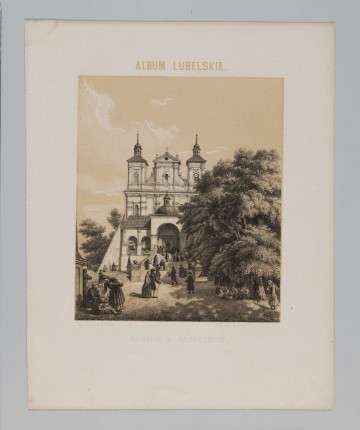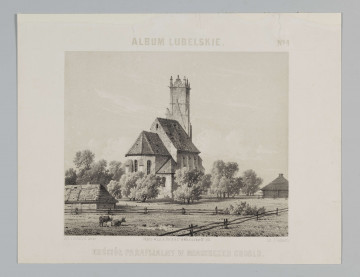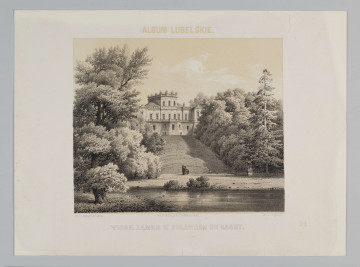
Church in Radecznica
1857
National Museum in Lublin
Part of the collection: Lubliniana. Painting views of Lublin and the Lublin Region
One aspect of the activities common in the nineteenth century connected with the study of mementoes of the national past was the effort to preserve and document the condition of objects, which was supposed to spread knowledge about the monuments of national architecture. Particularly those which, in a country deprived of sovereignty, could remind us of the former splendour and significance of places important to the free and independent homeland. It was done, among other things, by means of so-called picturesque albums, popular in the 19th century, which contained engravings showing views of buildings usually accompanied by short descriptions. The first publications of this type appeared on Polish soil at the beginning of the 19th century and gained popularity in the second half of the century. Thanks to the efforts of Adam Lerue, one of the most distinguished artists in the field of inventory of Polish monuments, the monuments of Lublin Governorate also had their own album. Drawings and watercolours by Lerue, depicting the most important architectural objects, were created during the inventory of historical monuments carried out in 1844-1855 by the Delegation for the description of ancient monuments in the Kingdom of Poland, headed by Kazimierz Stronczyński. They were included in the publication Album Lubelskie [The Album of Lublin] published in 1857-1859 by the Lithographic Company of Adolf Pecq and Co. in Warsaw. The lithographic plates of the views were prepared by Julian Cegliński and Władysław Walkiewicz. Each engraving was accompanied by a caption with the name of the object, sometimes expanded by the name of the founder or a short description testifying to the "past" of the building.
The parish church of St Catherine and St Florian in Golêbie was built in 1626-1634. It is distinguished by its two-tower façade, which has few equivalents in Polish architecture of that time, and the presence in its immediate vicinity of a Loretto House - one of the first buildings of this type in the country. Lerue captured only its gable, shown in the depth of the representation, concentrating on the view of the somewhat decaying temple and its surroundings. The poor condition of the composition is evidenced by the numerous losses of roof tiles, the dilapidated church wall and the appearance of a brick cottage within the enclosure that served the clergy who conducted special devotions to Our Lady of Loretto.
Author / creator
Dimensions
cały obiekt: height: 36,1 cm, width: 27,2 cm
Object type
graphics
Technique
lithography
Material
paper
Creation time / dating
Creation / finding place
Owner
The National Museum in Lublin
Identification number
Location / status

1857
National Museum in Lublin

1857
National Museum in Lublin

1857
National Museum in Lublin
DISCOVER this TOPIC
National Museum in Lublin
DISCOVER this PATH
Educational path